
a web page by Don Roberson |
BULBULS Pycnonotidae |
||
|
||
Some bulbuls are common and easily seen, making them very familiar to Old World birders in either Asia or Africa. An African example is Black-fronted Bulbul (left), widespread in southern Africa. It is in the genus Pycnonotus, which has more than 40 species spread from South Africa to Japan. It is curious and conspicuous and, like most bulbuls, is a generalist forager. It is equally adept at eating insect and small vertebrates as it is in finding fruit, berries, or pollen. [It is also a good example of what can be a problem with English names. It is often known as "Red-eyed Bulbul" in South African field guides, but there is another Pycnonotus bulbul called Red-eyed Bulbul in Asia: P. brunneus, which ranges from southeast Asia to Borneo and Sumatra. The Handbook of the Birds of the World chapter (Fishpool & Tobias 2005) deals with this problem by calling them "African Red-eyed Bulbul" and "Asian Red-eyed Bulbul," respectively, but those tongue-twisters are long and clunky, and I much prefer to use Red-eyed Bulbul for the Asian bird — which actually has red eyes — and use the alternative Black-fronted Bulbul for the African taxa, which actually has dark eyes and a conspicuous red eyering.] |
||
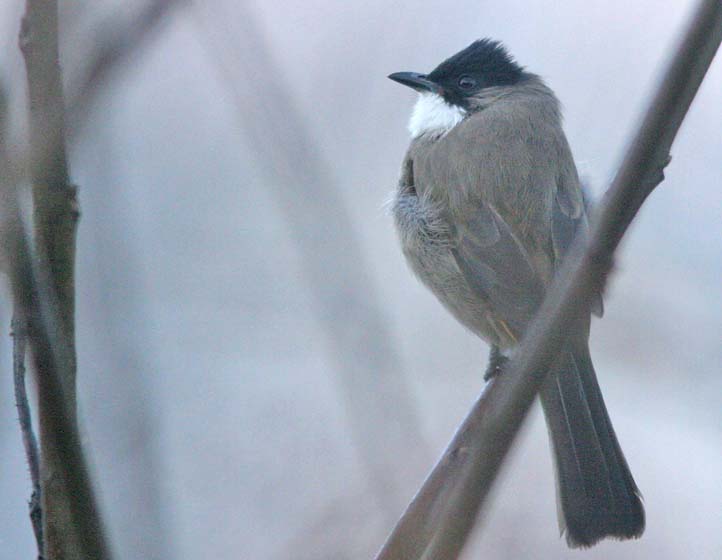 Although
bulbuls are a morphologically and ecologically homogenous group, they
evolved into two lineages eons ago: an Asian clade and an African clade
(Pasquet et al. 2001, Moyle & Marks 2006). It makes logical sense
to call those in the Asian clade "bulbuls," and those in the African
clade "greenbuls" (Johansson et al. 2007). The Brown-breasted Bulbul of China (right) is a Pycnonotus
bulbul within that Asian clade, but so is the Black-fronted Bulbul of
southern Africa shown above. Rather, the Asian clade arose in Asia and
then expanded westward, bring some "Asian bulbuls" to Africa, where
there are now three common species of Pycnonotus. Bulbuls in
the Asian clade are often gray and white, or brown and white — as is
Brown-breasted Bulbul — while the vast majority of the "greenbuls" in
Africa are primarily green or olive in color. Although
bulbuls are a morphologically and ecologically homogenous group, they
evolved into two lineages eons ago: an Asian clade and an African clade
(Pasquet et al. 2001, Moyle & Marks 2006). It makes logical sense
to call those in the Asian clade "bulbuls," and those in the African
clade "greenbuls" (Johansson et al. 2007). The Brown-breasted Bulbul of China (right) is a Pycnonotus
bulbul within that Asian clade, but so is the Black-fronted Bulbul of
southern Africa shown above. Rather, the Asian clade arose in Asia and
then expanded westward, bring some "Asian bulbuls" to Africa, where
there are now three common species of Pycnonotus. Bulbuls in
the Asian clade are often gray and white, or brown and white — as is
Brown-breasted Bulbul — while the vast majority of the "greenbuls" in
Africa are primarily green or olive in color. |
||
The plain dark-and-white patterns on Yellow-vented Bulbul and on White-eared Bulbul are relieved by conspicuous yellow undertail coverts (neither is shown in these particular poses); Red-whiskered has a prominent red spot (ear-tuft) behind the eye. Other fairly similar species (e.g., Red-vented Bulbul P. cafer in India, Sooty-headed Bulbul P. aurigaster in southeast Asia) have bright red undertail coverts. |
||
|
||
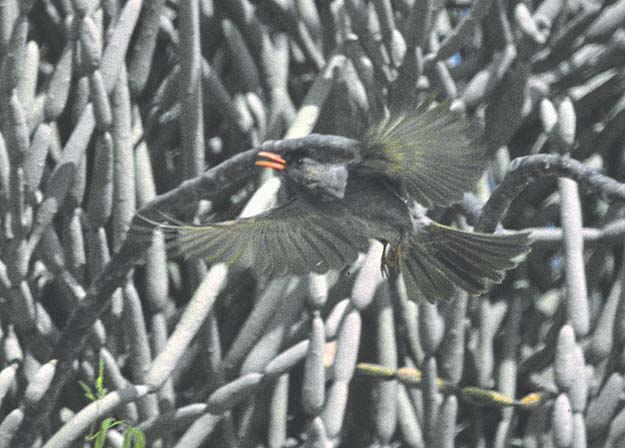 The outward radiation of Asian bulbuls includes the dispersal of bulbuls to islands in the Indian Ocean. One of those is Madagascar Bulbul (right), which is a sooty color with a black cap and red bill. Endemic bulbuls on Madagascar, the Seychelles (Hypsipetes crassirostris), Réunion (H. borbonicus), Mauritius (H. olivaceus) and the Comoros (H. parvirostris;
probably two species here) are all most closely related to other sooty
bulbuls in India and Asia. Although the Indian Ocean islands are much
closer to Africa today than they are to India, all appear to be evolved
from Asian ancestors (Warren et al. 2005). All are fairly similar,
differing in eye color (the Reunion Bulbul is white-eyed) or belly
color, and in vocalizations. The outward radiation of Asian bulbuls includes the dispersal of bulbuls to islands in the Indian Ocean. One of those is Madagascar Bulbul (right), which is a sooty color with a black cap and red bill. Endemic bulbuls on Madagascar, the Seychelles (Hypsipetes crassirostris), Réunion (H. borbonicus), Mauritius (H. olivaceus) and the Comoros (H. parvirostris;
probably two species here) are all most closely related to other sooty
bulbuls in India and Asia. Although the Indian Ocean islands are much
closer to Africa today than they are to India, all appear to be evolved
from Asian ancestors (Warren et al. 2005). All are fairly similar,
differing in eye color (the Reunion Bulbul is white-eyed) or belly
color, and in vocalizations. |
||
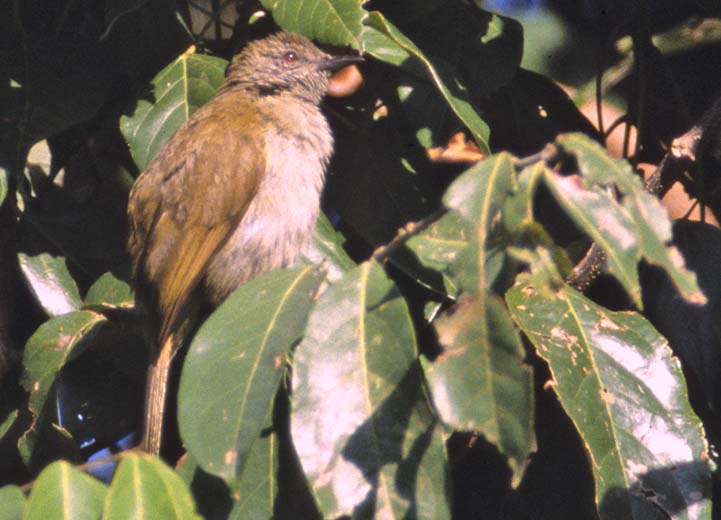 There
are at least 50 species of African greenbuls in the "African clade"
that evolved in sub Saharan Africa. Most are hard-to-see forest birds.
Some are canopy species, such as Slender-billed Greenbul
(left), but others are undergrowth skulkers and some bear names like
brownbuls or bristlebills. Some join mixed species flocks, including
the brown-bodied gray-capped Leaf-love Phyllastrephus scandens, and the very green-and-yellow Yellow-bellied Greenbul
(below). Many are birds of lowland forests, including Leaf-love and
Yellow-bellied Greenbul, but there is a set of montane species also
(Roy 1997). Johansson et al. (2007) proposed a new phylogeny for the
African greenbuls, dramatically shifting the species sequence into 13
genera. There
are at least 50 species of African greenbuls in the "African clade"
that evolved in sub Saharan Africa. Most are hard-to-see forest birds.
Some are canopy species, such as Slender-billed Greenbul
(left), but others are undergrowth skulkers and some bear names like
brownbuls or bristlebills. Some join mixed species flocks, including
the brown-bodied gray-capped Leaf-love Phyllastrephus scandens, and the very green-and-yellow Yellow-bellied Greenbul
(below). Many are birds of lowland forests, including Leaf-love and
Yellow-bellied Greenbul, but there is a set of montane species also
(Roy 1997). Johansson et al. (2007) proposed a new phylogeny for the
African greenbuls, dramatically shifting the species sequence into 13
genera. |
||
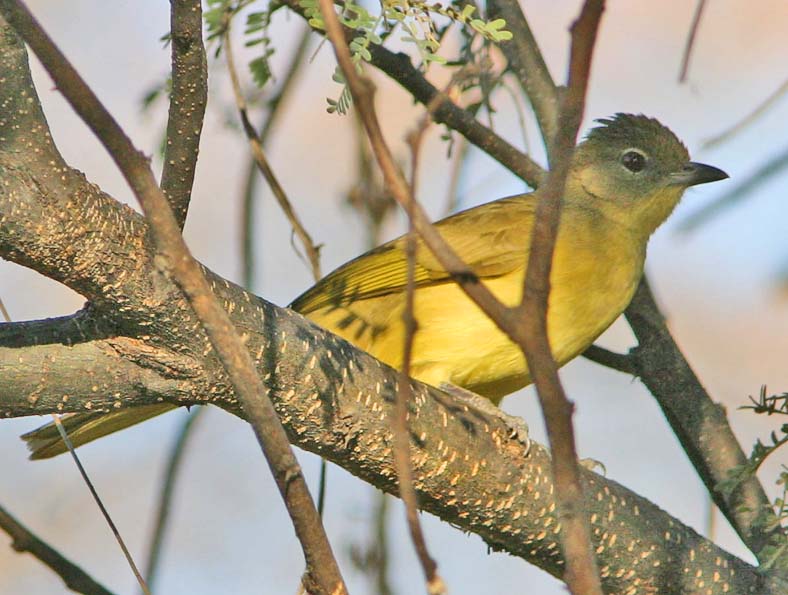 |
||
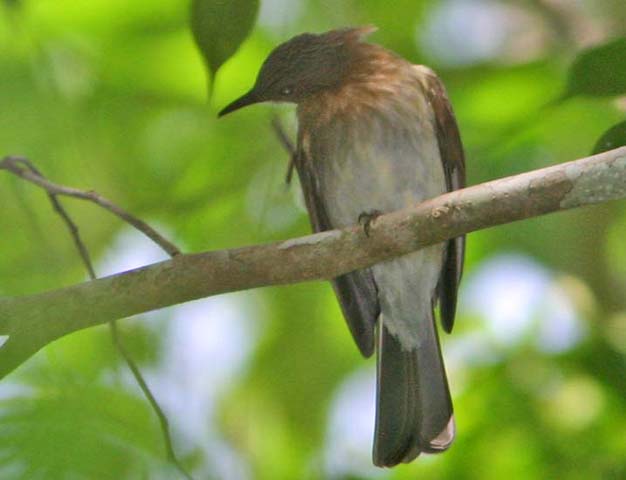 Recent
molecular research has shown that island bulbuls in the Orient are
significantly over-lumped. A recent genetic review of Philippine
species (Oliveros & Moyle 2010) found that at least four additional
species-level taxa existed there, and the authors did not have access
to DNA of all Philippine species, nor did they look at additional taxa
on Borneo or Indonesian islands. The "Philippine Bulbul Ixos philippinus" proved to be at least three species, which are better placed in genus Hypsipetes: Philippine Bulbul H. philippinus, with the nominate race on Luzon and race saturatior on Mindanao and nearby islands (i.e., on Bohol, right); Mindoro Bulbul H. mindorensis (Mindoro and Semirara), and Visayan Bulbul H. guimarasensis
(Panay, Negros, etc.). Birders had long suspected there were two or
more species among these bulbuls, based on plumage and vocal
differences. For example, the now-restricted Philippine Bulbul (shown
at right) has white shaft streaks to crown and throat, and the throat
is rusty, but the newly-split Mindoro Bulbul is dingy without either a
rusty throat or shaft streaks. Recent
molecular research has shown that island bulbuls in the Orient are
significantly over-lumped. A recent genetic review of Philippine
species (Oliveros & Moyle 2010) found that at least four additional
species-level taxa existed there, and the authors did not have access
to DNA of all Philippine species, nor did they look at additional taxa
on Borneo or Indonesian islands. The "Philippine Bulbul Ixos philippinus" proved to be at least three species, which are better placed in genus Hypsipetes: Philippine Bulbul H. philippinus, with the nominate race on Luzon and race saturatior on Mindanao and nearby islands (i.e., on Bohol, right); Mindoro Bulbul H. mindorensis (Mindoro and Semirara), and Visayan Bulbul H. guimarasensis
(Panay, Negros, etc.). Birders had long suspected there were two or
more species among these bulbuls, based on plumage and vocal
differences. For example, the now-restricted Philippine Bulbul (shown
at right) has white shaft streaks to crown and throat, and the throat
is rusty, but the newly-split Mindoro Bulbul is dingy without either a
rusty throat or shaft streaks. |
||
Only the atriceps race of Black-headed Bulbul Pycnonotus atriceps (left) is not well-differentiated from Bornean populations, as it is from the most recent invasion. But whether Borneo-Palawan populations of Black-headed Bulbul should be split from mainland Asian populations is not yet known. Given the general molecular diversity between island populations and the Asian mainland, I suspect that there will be evidence to support another split sometime 'down the road.' |
||
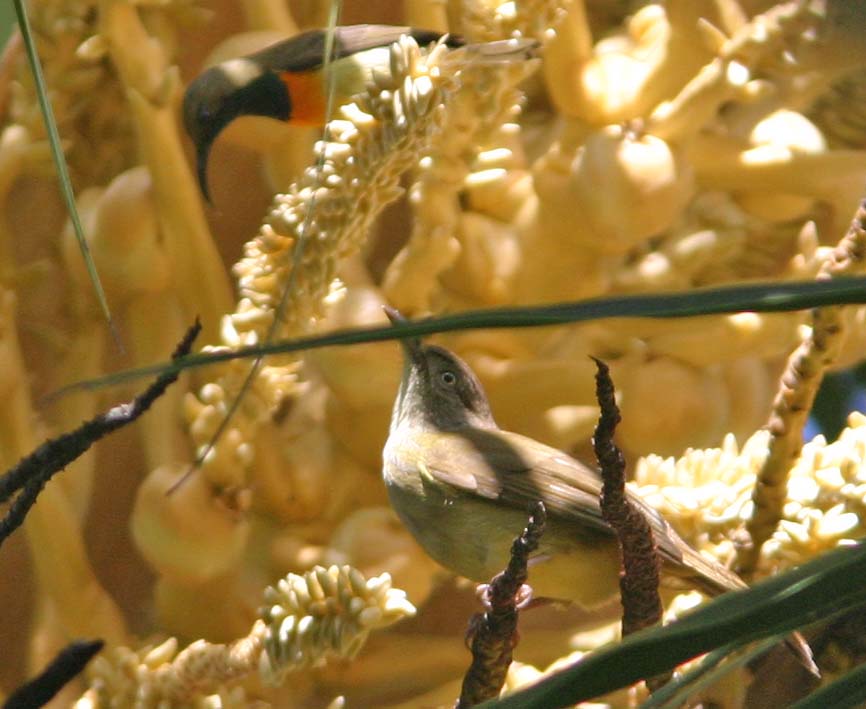 |
||
 Another Philippine endemic is Yellow-wattled Bulbul
(right, in a great shot by Blake Matheson). There are five named
subspecies; Oliveros & Moyle (2010) were able to analyze four of
them. They found that "considerable genetic divergence exists" between P .u. urostictus [central & southern Luzon]; atricaudatus [Bohol, Leyte etc.]; and philippinensis/ basilancius
[Mindanao]. There are also morphological differences: birds on Luzon
are dark-bellied while those on Mindanao are pale-bellied (note
contrast between breast and belly on this bird, of race philippinensis,
right). Yet, Oliveros & Moyle (2010) were conservative and
recommended "further study of their morphology, voice and ecology."
Likewise, their research showed considerable genetic differences
between mainland populations of Yellow-vented Bulbul and those on
Borneo, and again from those from some Philippine islands. There is
certainly much to learn about the taxonomy of many bulbuls and
greenbuls. Another Philippine endemic is Yellow-wattled Bulbul
(right, in a great shot by Blake Matheson). There are five named
subspecies; Oliveros & Moyle (2010) were able to analyze four of
them. They found that "considerable genetic divergence exists" between P .u. urostictus [central & southern Luzon]; atricaudatus [Bohol, Leyte etc.]; and philippinensis/ basilancius
[Mindanao]. There are also morphological differences: birds on Luzon
are dark-bellied while those on Mindanao are pale-bellied (note
contrast between breast and belly on this bird, of race philippinensis,
right). Yet, Oliveros & Moyle (2010) were conservative and
recommended "further study of their morphology, voice and ecology."
Likewise, their research showed considerable genetic differences
between mainland populations of Yellow-vented Bulbul and those on
Borneo, and again from those from some Philippine islands. There is
certainly much to learn about the taxonomy of many bulbuls and
greenbuls. |
||
It was recently learned, however, that the enigmatic Black-collared Bulbul Neolestes torquatus of central Africa — which some had proposed might be a shrike — is in fact within the bulbul lineage (Zuccon & Ericson 2010). Its origin goes back to the base of that lineage, and there is more to learn about its affinities, but it is not a shrike and is, for now, a bulbul. On the other hand, five species of assumed "greenbuls" in Madagascar, now known as tetrakas (genus Bernieria, Xanthornixis), are in a new family, the Bernieridae. |
||
Photos: The Black-fronted Bulbul Pycnonotus nigricans was at Augrabes Falls NP, South African, in July 2005. The Brown-breasted Bulbul Pycnonotus xanthorrhous was at Huayang, Shaanxi Province, China, on 9 Nov 2010. The Yellow-vented Bulbul Pycnonotus goiavier was at Manila, Luzon, Philippines, in Dec 2005. The Red-whiskered Bulbul Pycnonotus jocosus was at Ramnagar, India, in March 2001, and the White-eared Bulbul Pycnonotus leucotis was at Bharatpur, India, that same month. The Madagascar Bulbul Hypsipetes madagascariensis was north of Tulear, Madagascar, in Nov 1992. The Slender-billed Greenbul Stelgidillas gracilirostris was at Ruhiza, Bwindi-Inpenetrable NP, Uganda, in July 2002. The Yellow-bellied Greenbul Chlorocichla flaviventris was at Nkwassa, on the Kvanga River, Namibia, in July 2005. The Philippine Bulbul Hypsipetes philippinus saturatior was at Rajah Sikatuna NP, Bohol, Philippines, in Jan 2006. Both the Black-headed Bulbul Pycnonotus atriceps and the Sulphur-bellied Bulbul Iole palawanensis were in St. Pauls Subterranean NP, Palawan, Philippines, in Nov 2005. Blake Matheson photographed the Yellow-wattled Bulbul Pycnonotus urostictus in the PICOP forest of Mindanao, Philippines, in Jan 2006. The Mountain Bulbul Hypsipetes mcclellandii was at Foping Nature Reserve, Shaanxi, China, on 10 Nov 2010. Photos © Don Roberson, except the Yellow-wattled Bulbul © Blake T. Matheson and used with permission; all rights reserved. Bibliographic note: There is no "family book" per se, but a fine introduction to this family, with some fine photos, is in Fishpool & Tobias (2005). Literature cited:
|
 Bulbuls
are a large family of medium-sized, generally drab songbirds which form
a large part of the sylvioid radiation in the Old World. They are in
the evolutionary clade of passerines that includes swallows, larks,
babblers, and many families of Old World warblers.
Bulbuls
are a large family of medium-sized, generally drab songbirds which form
a large part of the sylvioid radiation in the Old World. They are in
the evolutionary clade of passerines that includes swallows, larks,
babblers, and many families of Old World warblers. 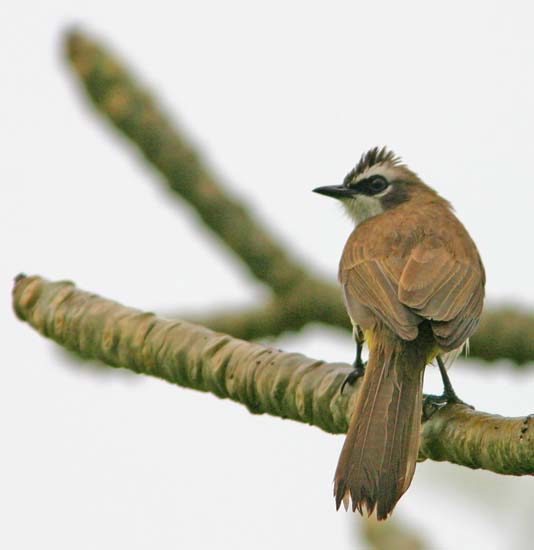 Among the Asian Pycnonotus bulbuls that feature a conspicuous black/gray/or brown-and-white pattern are Yellow-vented Bulbul
Bulbul (left; southeast Asia, Greater Sundas, Philippines; may be
composed of 3 species but further research needed; Oliveros & Moyle
2009); Red-whiskered Bulbul (below left; India through southeast Asia); and White-eared Bulbul
(below right; Middle East to western India). All are common,
conspicuous, open-country bulbuls. The latter two species have been
widely introduced outside their native range. Red-whiskered Bulbul has
non-native populations from Hawaii to south Florida to eastern
Australia, Brunei, and Arabia. White-eared Bulbul is now very common
along the eastern side of the Persian Gulf [Qatar, United Arab
Emirates, Oman] but was probably introduced there several hundred years
ago.
Among the Asian Pycnonotus bulbuls that feature a conspicuous black/gray/or brown-and-white pattern are Yellow-vented Bulbul
Bulbul (left; southeast Asia, Greater Sundas, Philippines; may be
composed of 3 species but further research needed; Oliveros & Moyle
2009); Red-whiskered Bulbul (below left; India through southeast Asia); and White-eared Bulbul
(below right; Middle East to western India). All are common,
conspicuous, open-country bulbuls. The latter two species have been
widely introduced outside their native range. Red-whiskered Bulbul has
non-native populations from Hawaii to south Florida to eastern
Australia, Brunei, and Arabia. White-eared Bulbul is now very common
along the eastern side of the Persian Gulf [Qatar, United Arab
Emirates, Oman] but was probably introduced there several hundred years
ago. 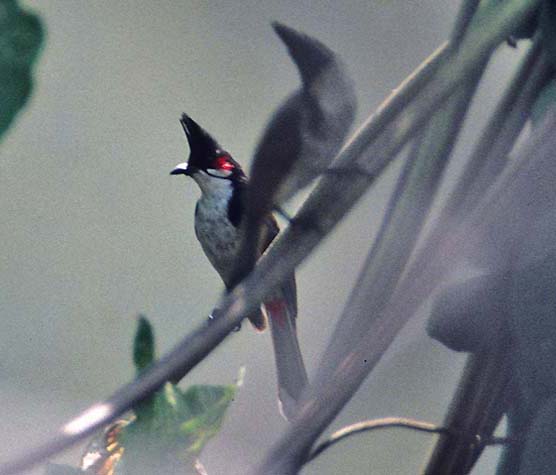
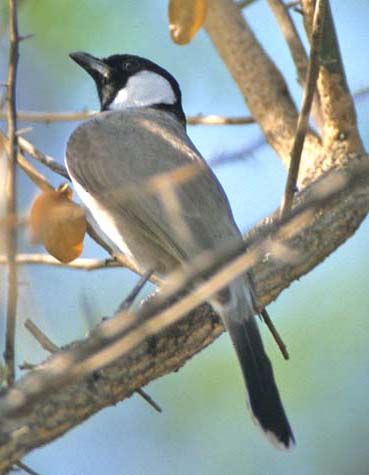
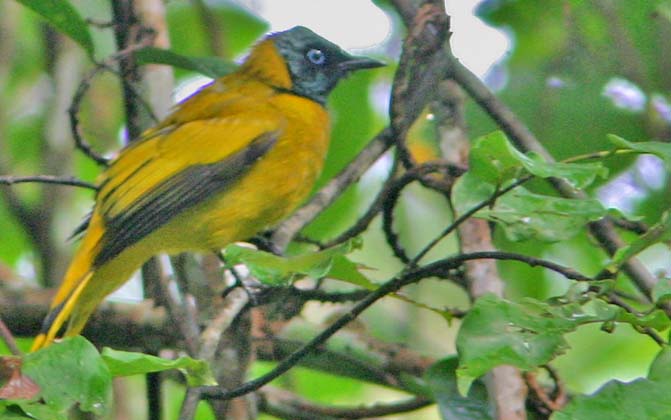 There
are four sympatric bulbuls on the Philippine island of Palawan. All
arrived during independent invasions from Borneo (Oliveros & Moyle
2010). Three have evidence of long isolation from Borneo. Sulphur-bellied Bulbul
(below, feeding in palm tree with Olive-backed Sunbird) has long been
considered an endemic. Oliveros & Moyle (2010) showed genetic and
morphological reasons to split the Palawan race of Olive-winged Bulbul Pycnonotus plomosus as a good species P. cinereifrons, and to split the Palawan race of Gray-cheeked Bulbul Alophoixus bres as a good species A. frater. [The English names were not proposed and remain to be sorted out.]
There
are four sympatric bulbuls on the Philippine island of Palawan. All
arrived during independent invasions from Borneo (Oliveros & Moyle
2010). Three have evidence of long isolation from Borneo. Sulphur-bellied Bulbul
(below, feeding in palm tree with Olive-backed Sunbird) has long been
considered an endemic. Oliveros & Moyle (2010) showed genetic and
morphological reasons to split the Palawan race of Olive-winged Bulbul Pycnonotus plomosus as a good species P. cinereifrons, and to split the Palawan race of Gray-cheeked Bulbul Alophoixus bres as a good species A. frater. [The English names were not proposed and remain to be sorted out.] 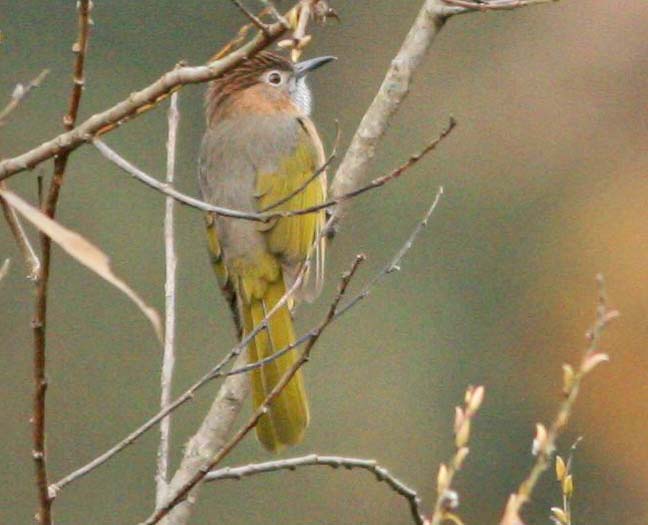 Taxonomy
aside, bulbuls are an interesting component of the Old World avifauna.
Many are skulkers in lowland forests. Others, such as Mountain Bulbul
(left, in China) are found only in the highlands. Many others, as we
have seen, are island endemics. Although almost all bulbuls are now
considered "resident," they have obviously shown the potential to
evolve and to disperse over long distances, including over substantial
oceanic barriers. The sheer number of species is staggering and can be
daunting for the traveling birder. And we are just now finding out that
we know very little about them at all.
Taxonomy
aside, bulbuls are an interesting component of the Old World avifauna.
Many are skulkers in lowland forests. Others, such as Mountain Bulbul
(left, in China) are found only in the highlands. Many others, as we
have seen, are island endemics. Although almost all bulbuls are now
considered "resident," they have obviously shown the potential to
evolve and to disperse over long distances, including over substantial
oceanic barriers. The sheer number of species is staggering and can be
daunting for the traveling birder. And we are just now finding out that
we know very little about them at all.